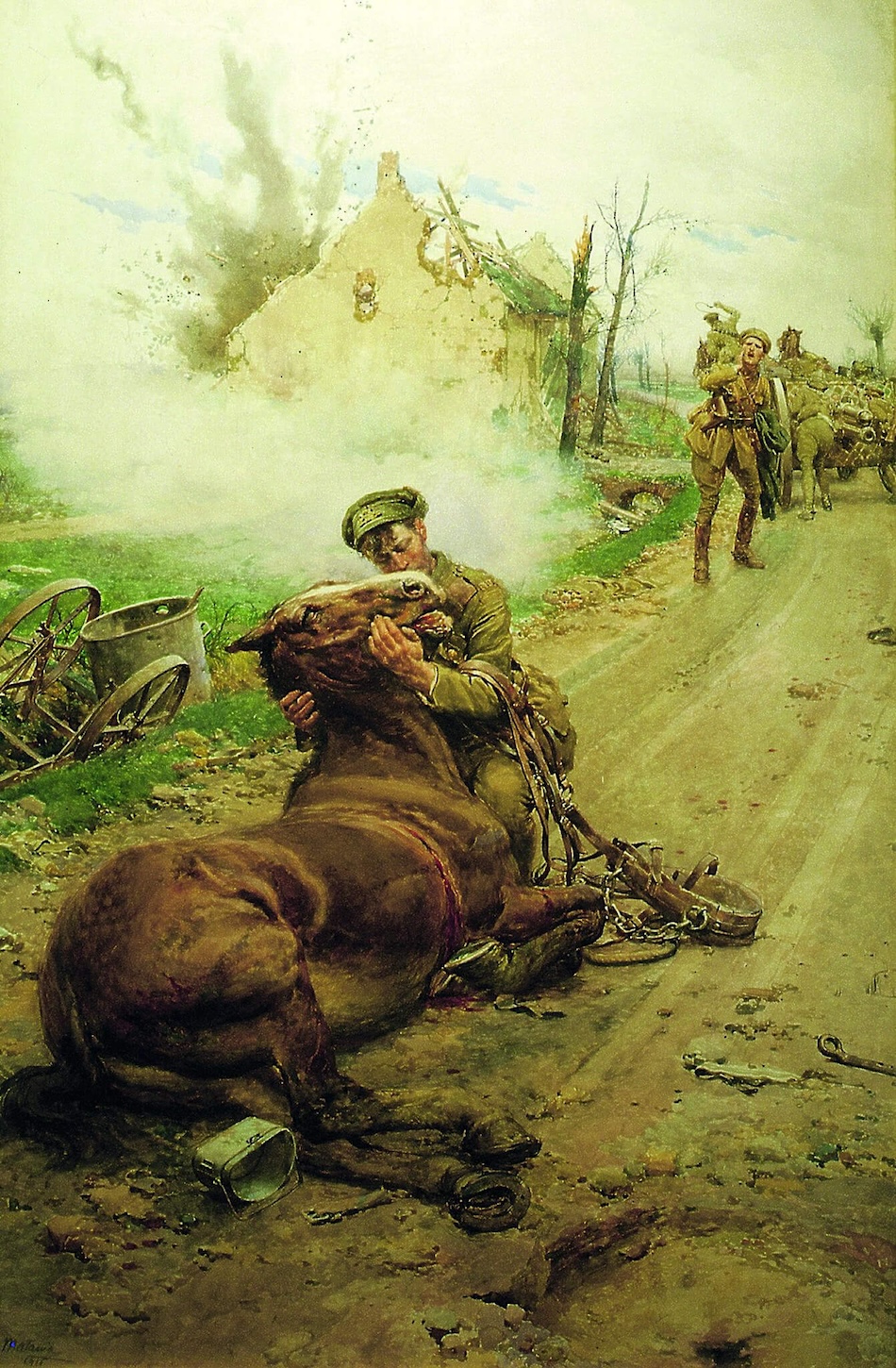At the start of the war in August 1914, the British Army had 25,000 horses. They employed 2 million by the end of the war. Horses came from all over the world. Although there are no direct records, some certainly were from St Ives. Read on to learn how the British Army procured and took care of the horses, and about the fate of equine survivors of WWI.
 |
| Horses at stables, 1914. |
Ready for war
Horses have a long history in the British Army. Cavalry units existed at the beginning of a standing army under the control of the Crown in the 1600s. They hauled artillery from the 1700s. Mounted infantry used horses for transport from the 1800s. Throughout, horses moved provisions and equipment.
The British Army used mechanised transport from the early 1900s. One limitation was the ability to increase production as war loomed.
The peacetime count of army horses was 20,000. There were a further 20,000 registered in reserve. The owners got paid 10 shillings a year retention fee (today £100) for each horse. The need for a war footing was 160,000 horses. That meant buying 120,000 extra horses. Support also needed to be in place. Vets, handlers, trainers, blacksmiths, farriers, grooms, and storemen. Equipment such as nose bags, blankets, harnesses, saddles, fodder. Finally, stables, veterinary surgeries and transport.
The British Army was well prepared. In 1912, the War Office conducted a census of horses. This identified locations, suitability, amount eaten, even the nearest train station. Of 2.5 million horses listed, under 1 million were suitable for military service. They also tested a purchasing scheme in 1913.
 |
| Struggling to free a horse and gun carriage from the mud. |
Horses during war
Declaration of war showed the British Army at its organisational best. Within the first few weeks, 120,000 horses were compulsorily purchased in Great Britain. By the end, that figure was over 1 million. Another 1 million came from abroad, 600,000 of these from Canada and the USA.
Horse purchasers travelled the country, using the 1912 census as a guide. To gain exemption, an owner had to prove their horses were essential for transport or agriculture. A fair market value paid didn't help if they still needed a horse. There was a shortage. Owners mourned the loss of horses they loved and trusted.
Some over-enthusiastic army purchasers commandeered pet ponies. The War Office received letters from distraught families. They set a minimum height of 15 hands (5 feet).
Horses used for cavalry divisions reduced through the war. They were vulnerable to machine gun fire and barbed wire defences. Increasingly, horses' major role was transportation of artillery, troops and supplies. Supply of fodder was in such short supply they were always hungry. It was a common sight to see horses trying to eat anything available, such as wagon wheels, blankets or hay nets.
Life expectancy was short. Soldiers could seek cover when attacked by shellfire. Horses remained in the open, attached to artillery or cart. They were a big target. Twice as many died from disease, starvation and overwork. They were wet and cold for months in winter, mired in mud. Many died on their feet, propped up by the mud. The average WWI death rate for UK soldiers was 9%. For horses, the estimate varies between 40% and 60%.
 |
| 'Goodbye Old Man', by Fortunino Matania, 1916. |
This touching painting shows a British soldier putting himself in danger to say farewell to his dying horse. The Blue Cross Fund commissioned it to raise money to relieve the suffering of horses in France and Belgium.
After WWI Armistice
Without horses, Great Britain would not have won WWI. Soldiers grew fond of their horses and were sad to leave them. So what was their fate when peace finally arrived?
Many were put down, too old or in poor health. The French and Belgium Governments bought tens of thousands, sent to slaughterhouses to feed a starving population. The youngest and healthiest stayed in the British Army. Those sold to local civilians did not always have a happy life thereafter.


No comments:
Post a Comment